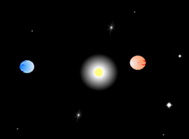





To date, around twenty planetary systems have been confirmed as orbiting stars other than the Sun. At least a further fifty or more are thought to exist from observational evidence. In fact, nearly every star that has been studied has revealed that a planetary system orbits it. Even binary stars, where the variation in the gravitational environment around the planet should make stable orbits unlikely, have been found to have planets. Planets seem to be normal rather than exceptions as far as stars are concerned. This should not be a surprise if the current theory of star formation is correct (and there is a lot of evidence that it is).
Because of the distances involved, and the limited resolution of the telescopes we are using to search for such planetary systems, most of the planets so far found are the size of Saturn or bigger and are therefore gas giants. However, it is likely that Earth-sized planets and rocky moons also exist in these systems. Conditions in other star systems are likely to be similar to those within our own Solar System, so there is good reason to suppose that conditions for life to exist and perhaps flourish elsewhere in the Milky Way Galaxy are common. It is likely to be a long time, though, before we can be sure.
There is another way, though, known as SETI, the search for Extraterrestrial Intelligence. To find out more about SETI visit:
For
more on planetary systems beyond ours visit:
Planetary
systems in orbit around other stars
It's
Real! - A planet beyond the Solar System
Extrasolar
Research Corporation
Searching for Extra-terrestrial planets:
Go
to
Home
| Space Station
| Mars | Rainforest
© 1999 Satellite Events Enterprises Inc.
